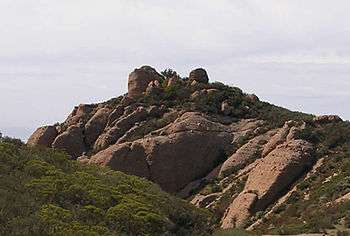Satwiwa

Satwiwa (Chumash for "the bluffs")[1][2][3][4] was a former Chumash village just north of Big Sycamore Canyon in southern Newbury Park.[5] Located adjacent to Rancho Sierra Vista[6][3] within the Santa Monica Mountains National Recreation Area,[7][8][9] it is one of the four primary entrances to the Santa Monica Mountains National Recreation Area.[10] The Satwiwa Native American Indian Culture Center is operated by the National Park Service in cooperation with the Friends of Satwiwa.[11]
The Ventureño Chumash Indians first settled in Satwiwa 13,000 years ago,[12] and lived in the village as recently as 2,000 years ago.[13] The village served as a post for travelers and traders who crossed the Santa Monica Mountains through the Sycamore Canyon in order to get from the Conejo Valley to the Mugu Lagoon and the Pacific Ocean.[14][3][15][5] The Chumash traded with the Gabrieleño-Tongva Indians, who mostly lived in areas of Los Angeles County.[1][3] Numerous Chumash artifacts and petroglyphs have been discovered in the surrounding area, particularly along the Arroyo Conejo on its way to its estuary in the Mugu Lagoon.[16][17] Satwiwa is situated at the foothills of Boney Mountain, which is a sacred mountain for the Chumash people.[18][13] Many of the artifacts are for display at the Satwiwa Native American Indian Culture Center and the Chumash exhibit at the Stagecoach Inn Museum in Newbury Park,[19] as well as at the Chumash Indian Museum in Thousand Oaks.
Satwiwa is still regularly used by Native-American groups, particularly by the Chumash Barbareño-Ventureño Band of Mission Indians for events such as community dancing and celebrations of various ceremonies, e.g. summer solstice and the Hutash ceremony.[20][11][21]
Bordering thousands of acres of wilderness in the Santa Monica Mountains, the fauna surrounding Satwiwa includes golden eagles, mountain lions, Valley coyotes, snakes, bobcats, foxes, falcons, and hawks.[22][23] Sometimes referred to as the backdoor to the Point Mugu State Park, the Backbone Trail crosses the Boney Mountain State Wilderness in the Santa Monica Mountains and ends in Point Mugu, California.[24][4][25]
References
- 1 2 Ayer, Eleanor H. (1992). Parks and Monuments of California: A Scenic Guide. American Traveler Press. Page 10. ISBN 9781558381193.
- ↑ McKinney, John (2004). California's National Parks: A Day Hiker's Guide. Wilderness Press. Page 320. ISBN 9780899973876.
- 1 2 3 4 "Map and Site Information: Rancho Sierra Vista/ Satwiwa - Santa Monica Mountains National Recreation Area (U.S. National Park Service)". Nps.gov. 2015-01-05. Retrieved 2016-02-14.
- 1 2 Sheer, Julie (2013). Moon Take a Hike Los Angeles: 86 Hikes within Two Hours of the City. Avalon Travel. Page 33.
- 1 2 "Parks". LAMountains.com. Retrieved 2016-02-14.
- ↑ Young, Don (2009). Southern California Adventure Guide. Hunter Publishing. Page 22. ISBN 9781588430915.
- ↑ Stienstra, Tom and Ann Marie Brown (2012). Moon California Hiking: The Complete Guide to 1,000 of the Best Hikes in the Golden State. Avalon Travel. Page 711. ISBN 9781612381633.
- ↑ Lightfoot, Kent G. and Otis Parrish (2009). California Indians and Their Environment: An Introduction. Page 258. University of California Press. ISBN 9780520244719.
- ↑ Eargle, Dolan H. (1992). California Indian Country: The Land & The People. Trees Company Press. Page 122. ISBN 9780937401200.
- ↑ Butcher, Russell D. (1999). Guide To National Parks: Pacific Region - American Samoa, California, Guam, Hawaii. Globe Pequot Press. Page 91. ISBN 0762705736.
- 1 2 Kennedy, Frances H. (2008). American Indian Places: A Historical Guidebook. Houghton Mifflin Harcourt. Page 243. ISBN 9780547523675.
- ↑ Bangs, Ray and Chris Becker (2004). 52 Great Weekend Escapes in Southern California. Globe Pequot. Page 55. ISBN 9780762730834.
- 1 2 "Museums, Festivals, Classes Open Door to Learning Indian History - Page 2 - latimes". Articles.latimes.com. 1990-03-10. Retrieved 2016-02-14.
- ↑ Maulhardt, Jeffrey Wayne (2010). Conejo Valley. Arcadia Publishing. Page 40. ISBN 9780738580395.
- ↑ Straus, Naomi (2004). Let's Go California 10th Edition. Macmillan. Page 474. ISBN 9780312335441.
- ↑ Ciolek-Torrello, Richard (2006). A Passage in Time: The Archaeology and History of the Santa Susana Pass State Historical Park, California. Statistical Research. Page 42. ISBN 9781879442894.
- ↑ Whitley, David S. and Ellen L. McCann (1980). Inland Chumash Archaeological Investigations. Institute of Archaeology. Pages 155 and 255.
- ↑ Riedel, Allen (2008). 100 Classic Hikes in Southern California: San Bernardino National Forest, Angeles National Forest, Santa Lucia Mountains, Big Sur and the Sierras. The Mountaineers Books. Page 118. ISBN 9781594851254.
- ↑ "Chumash Exhibit". Stagecoachmuseum.org. Retrieved 2016-02-14.
- ↑ "Chumash influence lingers". Vcstar.com. 2004-07-30. Retrieved 2016-02-14.
- ↑ "NEWBURY PARK : Chumash Event to Greet Solstice - latimes". Articles.latimes.com. 1991-06-19. Retrieved 2016-02-14.
- ↑ Riedel, Monique Del (2009). Best Easy Day Hikes Ventura. Falcon Guides. Page 49. ISBN 9780762751211.
- ↑ Smith, Jonathan (2015-01-08). "Livestock killed in local mountain lion attack | January 8, 2015 | www.theacorn.com". The Acorn. Retrieved 2016-02-14.
- ↑ Sanger, Kay and Tom Sanger (1990). Southern California for Kids. C.N. Potter. Page 12. ISBN 9780517573471.
- ↑ McKinney, John (2004). California's National Parks: A Day Hiker's Guide. Wilderness Press. Page 320. ISBN 9780899973876.
External links
- Satwiwa Native American Indian Culture Center - National Park Service
Coordinates: 34°9′1″N 118°57′41″W / 34.15028°N 118.96139°W